Renaissance Hong Kong Harbour View Hotel Boardroom, Mezzanine Floor
1 Harbour Road, Wanchai, Hong Kong

|
Lot: 8001
Made from the sands of Yixing, this vase has squared, downward turning corners and a short narrowed neck. This then flows into shoulders that continue into a rectangular midsection. Sitting on a flat square base, the vase continues to gradually narrow towards a square shaped bottom. The entire vase is covered in an azure glaze which seemingly pieces together broken fragments. Due to the thinness of the glaze at the vase's four corners, rugged lines of dark soil are exposed form underneath. The bottom is fully glazed with no writing. It's a square vase, with clean, streaming contours. The glazed surface gives a dignified elegant look. The piece was created by Dabin's pupil, Zhenchun, during the Yixing era. |
Estimate
25,000 - 38,000 101,000 - 154,000 3,200 - 4,900
|
Sold Price
36,000
144,000
4,645
|
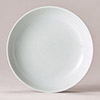
|
Lot: 8002
The plate opens outwards, with arching walls and a round base. A white glaze provides the entire surface with an elegant, radiant finish. Written under the glaze on the bottom of the plate are the words, Made in the Qianlong Period of the Qing Dynasty, written in seal script and arranged in three rows of six characters. The colors of glaze used in the state kilns during the Qing Dynasty have some correlation with the five traditional Chinese elements (wood, fire, earth, gold, water) and their five corresponding colors (blue, red, yellow, white, black). If looked at as an instrument of worship for royal ritual, the function of the white glaze coating is to be used to hold offerings given at the Temple of the Moon. |
Estimate
40,000 - 60,000 162,000 - 243,000 5,200 - 7,700
|
|
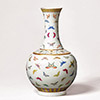
|
Lot: 8003
The opening of the vase turns outwards and has a long slim neck which smoothly curves into shoulders. Two golden rings encircle the shoulders and stick out from the surface. The midsection is ball shaped whilst the foot of the vase is round. The entire vase has been coated with a white glaze whilst the outer rim of the mouth has been circled with golden lines. Under the golden rim, motifs are painted in pastel colors. At the top of the shoulders are two golden rings, each different in diameter. Within the two rings are painted intertwining flower patterns. Towards the bottom, a circle of deformed lotus petal patterns are arranged. The patterns on the neck and midsection are formed from a variety of different pastel colored butterflies. The words, Made in the Guangxu Period of the Qing Dynasty, are written on the bottom in a iron red, Chinese calligraphy style and arranged in two lines of six characters. As this type of long necked vase with a ball shaped midsection was once used by Qing Dynasty to reward officials, they are often called reward vases. Reward vases often display a wide variety of decorations. Pastel colored butterfly vases were one of the standard styles from Guanxu Period. |
Estimate
70,000 - 100,000 283,000 - 405,000 9,000 - 12,900
|
Sold Price
144,000
576,000
18,581
|
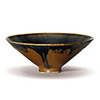
|
Lot: 8004
A bamboo hat shaped cup with an outward turning lip. Curving inward along the midsection, it stands on a round foot. The entire inner wall is covered in black glaze whilst the outer wall is covered in brown along the bottom. The round foot is unglazed and exposes the unrefined white earth underneath. The black used is as dark as ink, giving the surface a glistening finish. A brown rim is formed by the unglazed area between the inside and the outside of the opening where the two glazes meet. The intricacy of the item makes it stand out from the masses. |
Estimate
50,000 - 75,000 202,000 - 304,000 6,400 - 9,700
|
Sold Price
55,200
220,800
7,123
|
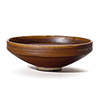
|
Lot: 8005
Vertical rim, with a slightly cinched opening. The midsection rapidly converges into a thin bottom which stands on a round foot. The entire inner and outer body is coated with a persimmon colored glaze. Meanwhile, the foot is left without the glaze and white earth can be seen underneath. It is a teacup with a gleaming white glaze and an overall dignified and beautiful style. It is a first-rate piece from the Ding series, crafted with simplicity and elegance. |
Estimate
80,000 - 120,000 324,000 - 486,000 10,300 - 15,500
|
|
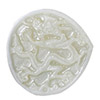
|
Lot: 8006
The board takes on a peach shape, with the pointy edge facing the right and a raised rim framing the four sides. The front utilizes subtractive carving techniques to etch a dragon. The dragon's neck is turned to face forwards whilst its eyes are round and shaped like a pig's nose. Meanwhile, its antennas drift forward. The dragon's long body and wheel shaped claws make for a splendid and lively image in the tradition of dragon patterns during the Wanli Period. The back is smooth and bare with no special polish. Three sets of elephant noses are perforated near the sides in a tripartite arrangement. The entirety of the jade body glistens whilst the sculpting is intricate. What these things create is a stand-out piece of art. |
Estimate
60,000 - 90,000 243,000 - 364,000 7,700 - 11,600
|
|
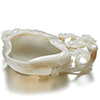
|
Lot: 8007
The entire piece is made from Nephrite whilst the texture is white and glistening. The body of the cup is shaped like a ganoderma mushroom and has an arbitrarily shaped opening and a middle hollowed out to hold water. The outer wall uses an embossing technique to create the appearance of a complete ganoderma. Along one wall of the abdomen, an openwork technique is used to sculpt a hornless dragon crawling upwards. At the other end, an openwork technique is also used to create intertwining studded ganoderma vines which serve as a handle. The lines of the ganoderma flow and hold a healthy posture. The patterns are arranged so as that from an observation of the surface, the images of the hornless dragon and ganoderma are combined as one. This also infers the meaning, be tight lipped and live comfortably. |
Estimate
120,000 - 180,000 486,000 - 729,000 15,500 - 23,200
|
|

|
Lot: 8008
Made from a single piece of Nephrite with a glistening texture, the inner section has brown tress marks. The body of the cup is shaped like a sunflower and the middle has been hollowed out. On the bottom, flower bud is lightly engraved. The walls of the cup compose the shape of the petals which are layered in pairs. One side of the midsection wall uses an openwork technique to sculpt the leaves. Meanwhile, leaves surround the four sides of the cup. The highly raised leaves not only depict liveliness and nature, the leaves coming out of the bottom of the cup also form a flat bottom. On the other side, leaves intertwine and flow around one side so as to be used as a handle. This is a rich, sophisticated piece of jade treasure with a diverse design. |
Estimate
80,000 - 120,000 324,000 - 486,000 10,300 - 15,500
|
|
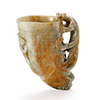
|
Lot: 8009
Carved from a single piece of Nephrite, parts contain a brown matte coloration with several naturally formed tress lines. The entire piece is made in the shape of a libation cup with a slightly curved body, wide at the top and narrow at the bottom. The inside wall of the cup has been polished to a fine finish whilst the outer wall is decorated with intricate patterns which are set out, from top to bottom, as follows. Near the lip are two consecutive lightning patterns and under these are a two tumbleweeds. On the midsection walls, two protruding lines serve as to separate a section of broad strap patterns. The insides of the broad strap patterns are decorated with wispy cloud patterns using embossing. The bottom of the mid-inner wall is given a lively fresh cloud image. Near the bottom of the cone is embossed a fire cloud decoration. On one wall of the libation cup there is an embossing of a dragon clinging to the side. On the other side, created with an openwork sculpting technique, another dragon clings to the wall with its head turned. Requiring a large amount of material and craftsmanship, the carving is classically elegant. It is a fine piece Ming Dynasty work imitating the Han Dynasty style jade libation cups. |
Estimate
420,000 - 600,000 1,700,000 - 2,429,000 54,200 - 77,400
|
|
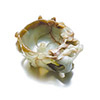
|
Lot: 8010
Made entirely of yellow Nephrite with parts of brown matte coloration. The body of the cup is shaped as a sunflower, with curled petals. In the center of the inner wall there protrudes a flower bud in the shape of a column. Starting from the pedicle head at the bottom, branches circulate out. The branches turn through several degrees, whilst the three dimensional look is created by an embossing technique. At the same time, the yin and yang of the flower petals are further simulated down to the last detail. It is as if a real sunflower is opening before the eyes. It is a gorgeously styled cup, formed from stems and petals. It is a state of the art piece of artistic treasure. |
Estimate
90,000 - 130,000 364,000 - 526,000 11,600 - 16,800
|
|
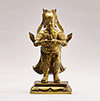
|
Lot: 8011
Gilt bronze figure wearing a helmet with a knot on top and a conical cap that spreads to cover the shoulders. With a fair and handsome face that appears to be powdered, and lips that are red and full, the figure exudes a youthful energy beneath its armor and boots. In particular, a fine level of craftsmanship can be seen in the knee pieces. Both arms cross in front of its chest whilst one hand holds an official government seal. Standing on a low, rectangular seat, this figure is a standard representation of Guan Ping. |
Estimate
100,000 - 150,000 405,000 - 607,000 12,900 - 19,300
|
|

|
Lot: 8012
This gilt bronze seated figure wears a scarf over its head and a conical cap that spreads across its shoulders. Featuring thick eyebrows, a moustache, and a goatee beard in five tufts, the plump face carries a solemn expression. The figure wears gold armor, robes, and a leather belt. Both arms hang naturally. The right arm appears as if ready to bow, whilst a clenched fist rests lightly near its waist. Its left palm faces downwards, gently touching its thigh. Robes drape down its knees. On a cloud, the figure looks to be squatting comfortably. |
Estimate
150,000 - 220,000 607,000 - 891,000 19,300 - 28,400
|
|
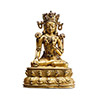
|
Lot: 8013
This gilt bronze figure wears a three-leaf crown inlaid with various jewels over a top knot. With elegant, white eyebrows and earrings hanging from its ears, it carries a solemn and peaceful expression. The top half of its body is bare. Lotuses cover its shoulders. Magnificent wreaths hang in front of its chest. Armlets are worn across both arms. The left arm is bent at the elbow in front of the chest, while the right arm hangs naturally with palm gently on top of its knee. A dress is draped tightly across its lower body as it sits in a full-lotus posture atop a lotus. This is a unique item depicting Buddha donning a leaf crown whilst wearing a solemn expression. It is indeed a superb figure relic from the Yuan Dynasty. |
Estimate
150,000 - 220,000 607,000 - 891,000 19,300 - 28,400
|
Sold Price
156,000
624,000
20,129
|
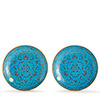
|
Lot: 8014
Metallic bodies, wide mouths, shallow abdominal arcs, and round feet. A translucent light blue enamel is applied to the center of plates and their outer walls. The light blue foundation of glaze is highlighted with red, blue, green and other colors. Three layers of patterns decorate the center of the plates. From the inside out, these can be categorized as: swirling flowers, interlocking lotuses, and continuous curly grass patterns. Worthy of particular mention are the gold crochets, part of the decorative patterns that provide the artistic and visual effect of a cloisonne. Furthermore, the outer abdominal wall is comprised of three sets of curly grass patterns, a white enamel glaze covering the entire bottom section, and the four characters, Rui Hsin Tang Zhi, written across two lines in the interior of the bottom. |
Estimate
120,000 - 180,000 486,000 - 729,000 15,500 - 23,200
|
|

|
Lot: 8015
A greenish-white jade rectangular table screen with partial brown spots and carvings on both sides. The front features a relief of a vast landscape of towering mountains, amongst which are several traditional pavilions. A winding path alludes to the poetic imagery of A thousand hills, but no birds in flight; Ten thousand paths, with no persons in sight. The back features a gold foil engraving of an imperial poem, Living amongst riches did not bring peace, so I retreated to Song Liao Mountain to live a hermit's life. A period of solitude brings joy to the mind, thus I plan to ride my horse to a far away place. Here, with its crisp and clear waters, is like no other place on earth. Vast nature stretch beyond, inviting me to live within her in solitude. The calligraphic work is of a orderly and flamboyant style, evoking a temperament of dignity. |
Estimate
800,000 - 1,200,000 3,239,000 - 4,858,000 103,200 - 154,700
|
|

|
Lot: 8016
Four lush white Nephrite pieces in the form of a plaque. With the exception of the first and last plaques that each have one side decorated with an intricate high relief of two dragons, the plaques are inscribed in gold with the Ballad of the Old Cypress by an officer of Emperor Qianlong. In is like bronze, it's roots are like stone. Its frost-white bark has been worn away by rain; forty people could encircle it; jet black in colour it rises into the sky two thousand feet. Lord and minister held a timely meeting together; the tree is still cherished by the people. Clouds come and the vapour links the length of Wu Gorge; the moon comes out, and the cold penetrates the whiteness of the snowy mountains. One remembers that formerly the road wound round the pavilion east of the Jin River; the former lord and military official shared the remote shrine. The lofty trunk and branches have towered over this countryside since antiquity; hidden paintings within the doors of the shrine. Although isolated, it is entrenched in the earth; Reaching into the sky, high and alone, there is intense wind. It is supported by the power of the spirit; its uprightness originates in the work of Nature. A great building, if it leans, needs beams and poles; Ten thousand oxen turn their heads; it is as heavy as a mountain. It does not reveal its hidden meaning, yet the world is already stunned; It does not reject being felled, but who could move it? How can the bitter heart of the tree avoid enduring crickets and ants; its fragrant leaves are in the end home to phoenixes. Gentlemen aspiring to benevolence – do not complain or lament; since ancient times, talent has been hard to use. The last plaque features two two-character seals, Bi De and Lang Run. It is dated as being from winter of the Dingmao Year. |
Estimate
3,000,000 - 4,600,000 12,146,000 - 18,623,000 386,800 - 593,200
|
|
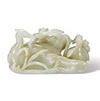
|
Lot: 8017
Created from Nephrite, this solid piece is large enough to be held with two hands. Brown spots and natural marks cover the jade. It features carvings of three egrets floating in a lotus pond, with two back-to-back egrets creating a playful image in the center. The two egrets beaks are touching a lotus. The third egret, which is smaller, is positioned between to two large egrets and has its wings spread as if it is about to take flight. Where the egret meets the water, intricate carvings of water ripples out. The composition features are perfectly in proportion and the imagery is vivid. The egrets, lotus, and motion of taking flight all allude to the auspicious message, Yi Lu Lian Sheng. |
Estimate
800,000 - 1,200,000 3,239,000 - 4,858,000 103,200 - 154,700
|
|

|
Lot: 8018
A flying bat carved into smooth Nephrite. The front features a bat with its wings spread. Detailed carving of the bat's wings reveals the underlying skeletal structure. Decorative cloud patterns are carved onto its wings. The back side is sculpted into the form of a ganoderma, making the piece appear more three dimensional whilst alluding to the form of a ganoderma. Additional ganoderma and auspicious patterns are a symbol of longevity and good fortune. |
Estimate
60,000 - 90,000 243,000 - 364,000 7,700 - 11,600
|
Sold Price
72,000
288,000
9,290
|
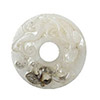
|
Lot: 8019
Premium white Nephrite with partial grey markings. Its flat disk form has a small hole. The two sides both feature carvings. One side, a high relief pair of hornless dragons, one small and one large, can be found. Their long bodies are curled and feature two pronged tails. The smaller dragon is shorter and is decorated in ink color to emphasise the auspicious meaning of imperial lineage. The other side features low relief cloud patterns. With orderly composition and exquisite craftsmanship, this jade piece is a fine work of art. |
Estimate
60,000 - 90,000 243,000 - 364,000 7,700 - 11,600
|
|

|
Lot: 8020
Lush white Nephrite with brown veins, carved into the shape of a mountain and decorated with a landscape mural. Cascading slopes and towering crags imbue the work with an emboldened artistic aura. Upon closer inspection, horses can be seen roaming on a plateau next to a creek. The horses come in many forms; standing, resting, grazing, etc. The theme of the entire work is set by a herder pulling a horse next to a forest, located in the lower right hand side of the piece. |
Estimate
1,800,000 - 2,800,000 7,287,000 - 11,336,000 232,100 - 361,100
|
|
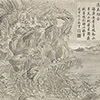
|
Lot: 8021
The engraving commemorates Emperor Qianlong's military campaign in Formosa from 1786 to 1788. The scene depicts the battle of Xiaobantian. In 1788, famous court painters Yao Wenhan, Yang Dazhang, Jai Quan, Tse Sui, Zhuang Yude, and Li Ming were summoned to create a total of twelve engravings. The twelve Douliumen, Conquer of Douliumen, Conquer of Dali, Attack on the Mountain Xiaobantian, Battle at Kuzhai, Capture of the rebel chief Lin Shuangwen, Battle at Jijipu, Battle at Dawujing, Capture of Zhuang Datian, Crossing the Ocean and the Triumphant Return, and Victory Banquet. The original engravings are now located at the Ziguang Pavilion in the Zhongnanhai. In 1791 and 1792, this series of copperplates was engraved by the Qing Construction Office. The inscription on the top left corner is a poem composed and written by the Qianlong Emperor. The poem states, At dawn, I received a report from the barracks. The report said that the soldiers attacked Mountain Xiaobantian. They captured the family of the thieves a while ago, but they have escaped. The soldiers fought for almost ten days with a total of almost two thousand people. I have told the soldiers many times to be cautious and not to delay the fighting. The leader has worked very hard so I can accept his apologies. I have handed out rewards and punishments according to the soldiers, and I hope that they can be completely successful in their mission next time. Note: Fu Kang-An and others had reported their attack on the thieves at Mountain Xiaobantian to the memorial court. The soldiers surrounded and intercepted the rogue leader. Emperor Qianlong decided to write a poem recording this event in 1788. |
Estimate
80,000 - 120,000 324,000 - 486,000 10,300 - 15,500
|
|
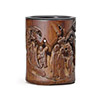
|
Lot: 8022
Held up by three short legs, this bamboo carving possesses a round opening and a cylindrical abdominal. The rim is inlaid with a ring of rosewood. The literary pictures on the outer wall were carved by integrating the techniques of openwork and incision. An openwork technique is used to construct the appearance of a rocky mountain. With the full use of openwork, the outer appearance seems to possess a sense of visual penetration. Close-up, towering pines offset the ease of green peaks, and we are able to see a gathering of elegant women. Wearing graceful clothing, the noble people bear a sense of casual elegance. On the side, a child servant holds a string instrument whilst following them closely. The poetic scene of a cultured gathering plays out amongst a melody of clear strings. |
Estimate
90,000 - 130,000 364,000 - 526,000 11,600 - 16,800
|
|
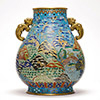
|
Lot: 8023
With a metal body, this item has a round mouth with protruding rimmed edges and shoulders that slope into a drooping abdominal. The abdominal gradually closes downwards from the middle. The item is held up by a circular foot. A pair of gilded copper Chi dragons are positioned on either side of the joint between the shoulders and abdominal. The abdominal walls are coated with a light blue enamel glaze as a base coat. The decoration on the filigree enamel abdominal is of a hundred deer. The area below the rim is decorated with a continuous triangular geometric pattern of one circle to every two squares. Near the bottom, there is a circular pattern of deformed banana leaves, whilst outside of the circular foot, floral decorations can be found. The composition of the hundred deer is inextricable. Under pines and cypresses, a herd of deer are leisurely running around, creating a peaceful scene of well-being. It is a piece of a hundred deer that mimics the shape of porcelain, also known as a piece of a hundred deer heads. This is an integral furnishing to the Qing Dynasty palace. |
Estimate
700,000 - 1,000,000 2,834,000 - 4,049,000 90,300 - 128,900
|
|
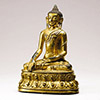
|
Lot: 8024
This gilt bronze figure has a thick gold coating. Sakyamuni Buddha possesses high, spiralling hair and a crown of jewelry, as well as an all-seeing third eye between the eyebrows. Beads hanging from both ears seem to form a square with the head. With curved eyebrows and a smiling face, Sakyamuni Buddha wears a solemn expression. A tightly-fitted thin robe hangs over the right shoulder. The figure's left hand strikes a meditative gesture, whilst the right hand forms the gestures touching the earth. The figure sits cross legged atop a lotus pedestal. |
Estimate
360,000 - 500,000 1,457,000 - 2,024,000 46,400 - 64,500
|
|
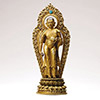
|
Lot: 8025
This gilt bronze figure has a thick gold coating. In a standing position, Maudgalyayana possesses a square head with a round top. With beads hanging from both ears and a benevolent face, the figure wears a chest robe on its upper body and a dhoti on its lower body, matching the appearance of a Buddhist monk. The figure's left arm is pressed against the chest for mendicancy, whilst the right arm hangs down naturally holding a cane (lost). The dhoti tightly fits the lower body with smoothly flowing pleated lines. Barefooted, the figure stands on a lotus pedestal. There is a flame pattern branded on its back. This statue of Maudgalyayana stands upright, embodying the spirit of heroism. The clothing lines seem natural and realistic. The statue bears the fine details of carving. This is a rare Buddhist statue of exceptional value. |
Estimate
550,000 - 800,000 2,227,000 - 3,239,000 70,900 - 103,200
|
|
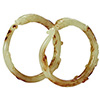
|
Lot: 8026
Specially selected from yellow Nephrite, the jade of these items is purely colored. Some parts contain a brown matte coloration. The bodies of the bracelets are formed into Chi dragons with their heads connected to their tails. With fat and lean bodies integrated together, the curves of the dragon are graceful and elegant. There are embossed money mice near the ends of the bracelets, forming a Zi-Chen theme. The mouse is ordered as Zi in the Chinese zodiac and the Twelve Earthly Branches, whilst the dragon is ordered as Chen. Therefore, the combination of two images embodies the meaning of Zi-Chen. In the Han Dynasty, the meaning of blessings and peace was bestowed upon Zi-Chen. However, in the Ming and Qing Dynasties, Zi-Chen obtained the auspicious connotation of having great hopes for one's offspring. |
Estimate
500,000 - 750,000 2,024,000 - 3,036,000 64,500 - 96,700
|
Sold Price
600,000
2,400,000
77,419
|
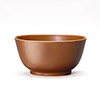
|
Lot: 8027
The bowl features a wide mouth, a deep abdominal arc that gradually closes downwards, and a circular foot. A bright and shiny persimmon glaze is applied over the inside and outside of the whole body. The bottom of the foot is adorned in white glaze. Within the circular base, six Chinese characters meaning, Made in the Daoguang Period of the Qing Dynasty, are inscribed across three lines. Also called sauce glaze, persimmon glaze is so called as it pairs persimmon soil with glaze. The high-temperature glaze is based on iron colorants. This Daoguang persimmon glazed bowl exudes a pure and shiny color. Featuring plump lines, it is indeed a classic Qing Dynasty boutique.Mark |
Estimate
80,000 - 120,000 324,000 - 486,000 10,300 - 15,500
|
|
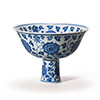
|
Lot: 8028
The bowl features a mouth that opens outwards, a deep abdominal arc that gradually closes downwards, and a stem foot that holds the cup high. The whole body is painted with hibiscus flowers. Two parallel string patterns decorate the center of the bowl, as well as two interlocking hibiscuses. There are six interlocked hibiscuses on both the inner and outer abdominal walls. Three interlocked hibiscuses adorn the walls of the foot. Within the conjunction of the abdominal and foot, four Chinese characters meaning, Made in the Xuande Period, are inscribed across two lines. |
Estimate
3,000,000 - 4,600,000 12,146,000 - 18,623,000 386,800 - 593,200
|
|

|
Lot: 8029
The plates both feature wide mouths, arch abdominals, and circular feet. On the inner walls, the areas around the rims and the bowls' centers are each decorated with two blue sting lines. Inside the string lines and within the center of the bowls, each contains a pair of symmetrical lucky phoenix cloud patterns. The image featuring a curly grass style tail is a male phoenix, while the image featuring a ribbon tail is a female phoenix. The blank spaces between the lucky phoenix clouds are covered in yellow glaze, whilst the abdominal walls are decorated in lucky phoenix cloud patterns. The outside parts of the patterns are also covered in a yellow glaze. Within the circular base, six Chinese characters meaning, Made in the Daoguang Period of the Qing Dynasty, is inscribed across three lines. |
Estimate
150,000 - 220,000 607,000 - 891,000 19,300 - 28,400
|
|
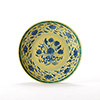
|
Lot: 8030
This plate features a wide mouth, arch abdominal, and circular foot. With a yellow base, blue and white floral patterns serve as the main decoration. Within the circular lines, there is a bouquet of lotus flowers with broken branches. There are two continuous honeysuckle patterns near the rim of the inner walls. A pattern featuring lotus flowers with broken branches are situated below the honeysuckle pattern. A circular lightning pattern is adorned on the outer wall. There are two continuous honeysuckle patterns near the bottom of the outer walls. A pattern of lotus flowers with broken branches is situated within the two patterns. Under the glaze on the bottom of the plate can be found the words, Made in the Qianlong Period of the Qing Dynasty, written in seal script and arranged in three rows of six characters. |
Estimate
1,000,000 - 1,500,000 4,049,000 - 6,073,000 128,900 - 193,400
|
|
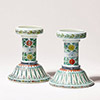
|
Lot: 8031
A pair of candle holders with a vertical rim and a cylindrical belly. A circle of patterns is carved into either end and supported by a high, round, outward turning foot. A blue flower pattern decorates the rim in a thin circle. Below this can be found eight layers of Doucai patterns, including honeysuckle patterns, lotus patterns, geometric/Fanglei patterns, Ruyi cloud patterns, lotus petal patterns and scroll designs. Under the glaze on the bottom are two lines of six characters stating, Made in the Yongzheng Period of the Qing Dynasty, in regular script. |
Estimate
1,500,000 - 2,200,000 6,073,000 - 8,907,000 193,400 - 283,700
|
|
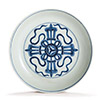
|
Lot: 8032
The plate has a wide opening, a curved belly and a round foot. On the wall near the rim and on the bottom are two circles of fine blue and white patterns with three layers of 147-character Sanskrit writings in between. On the inside of the rim and at the center of the plate are two circles of fine bow string pattern, with an extra embellishment of blue Shizi- Knot Baochu pattern at the center. In addition, on the wall of the round foot there are two more circles of fine bow string pattern. On the bottom are two line of six characters, Made in the Yongzheng Period of the Qing Dynasty, written in regular script inside two blue circles. |
Estimate
600,000 - 900,000 2,429,000 - 3,644,000 77,400 - 116,100
|
|
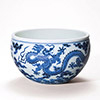
|
Lot: 8033
A BLUE AND WHITE SEAWATER CLOUD DRAGON JUG
Qianlong Six-Character Mark and of the Period (1736-1795) The jug has a wide opening and a curved belly that gradually narrows onto a concave bottom. It is decorated with a glazed blue and white pattern across the entire body. On the wall beneath the rim and near the foot are two circles of fine bow string patterns with an extra circle of roaring wave pattern on the bottom. On the wall of the belly are two dragons chasing each other amid clouds of fire, with one looking over its shoulder, and one ready to soar. The two creatures stare at one another intensely, baring their teeth and swinging their claws, looking bold and powerful. On the bottom, six characters, Made in the Qianlong Period of the Qing Dynasty, written in seal script. |
Estimate
800,000 - 1,200,000 3,239,000 - 4,858,000 103,200 - 154,700
|
|

|
Lot: 8034
Starting with an opening that has an outward turning rim and dropped shoulders, the body narrows gradually below the neck. It narrows again below the round belly onto a round foot. The entire piece is of white glaze with blue and white pattern decorating the walls. Below the rim is a circle of Ruyi cloud patterns. As for the neck and abdominal region, they are covered with a lotus pattern. Separating the two types of pattern is a continuous geometric/Fanglei pattern and another Ruyi cloud pattern. The Ruyi cloud pattern here is slightly different from that below the rim. There is a circle of lotus petal pattern near the foot and a circle of scroll designs on the wall of the foot. On the bottom, Made in the Qianlong Period of the Qing Dynasty, is written in seal script across three lines of six characters. |
Estimate
260,000 - 380,000 1,053,000 - 1,538,000 33,500 - 49,000
|
|
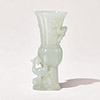
|
Lot: 8035
This vase is made from an entire piece of fine Nephrite. It consists of an oval opening, a flat rim, a neck that narrows gradually into a squash-shaped, round drum belly and a tall, round, outward angled foot on the bottom. At either end of the belly walls are two circles of raised bow string patterns. There are also two horizontal depressed prismatic lines running through the entire vase. A dragon in high relief is imprinted on one side of the neck and a semi-three dimensional phoenix is carved on the bottom. The dragon and the phoenix compliment one another and add to the charm of this elegant vase. |
Estimate
200,000 - 300,000 810,000 - 1,215,000 25,800 - 38,700
|
|

|
Lot: 8036
The plate consists of a wide opening with an outward angled rim, a shallow curved belly, a cinched waist and a round foot. Fired upside-down, this piece has bronze edges and an unglazed rim. A Huahua technique is used to decorate the center of the plate with a Xuancao pattern. The entire piece is covered with a white glaze, with tear marks from glaze build-up on the walls. Due to an early unearthing, the glazed surface is covered with damage marks. However, the clean contours and vivid patterns still shine through this beautiful plate as it lives up to the reputation of Ding porcelains. |
Estimate
360,000 - 480,000 1,457,000 - 1,943,000 46,400 - 61,900
|
|
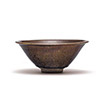
|
Lot: 8037
This purplish-black bowl consists of a wide opening, an outward angled rim, a deep curved belly, a lean base and a small round foot. Aside from the bottom, a black glaze covers the entire bowl, both on the inside and on the outside with a circle of build-up near the base. The black glaze surface has a brilliant shine and is filled with a golden oil-spot pattern. The placement of the oil spots is natural, abundant and ever-changing; indeed, a true feast for the eyes. |
Estimate
100,000 - 150,000 405,000 - 607,000 12,900 - 19,300
|
|
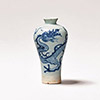
|
Lot: 8038
This piece has a small round opening, a short inward-slanting neck, broad shoulders and a belly that narrows gradually onto a round foot. With the exception of the bottom from the bottom, the entire bottle is covered in a white glaze with blue and white patterns. On the wall of the belly is a drawing of a dragon in march. The vivid drawing of the dragon with its head turned and hairs flying gives off a sense of speed. This mieping, with beautiful contours and lively drawings, is a refreshing yet sophisticated Yuan Dynasty blue and white piece. |
Estimate
300,000 - 460,000 1,215,000 - 1,862,000 38,700 - 59,300
|
|
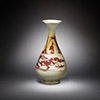
|
Lot: 8039
This bottle consists of an angled mouth, a long slim neck, dropped shoulders and a dropped belly supported by a round, outward angling foot. The entire body is covered in white glaze with iron red decorative patterns. There are two circles of bow string patterns on either end of the neck. The bow string patterns are made of simple Jianyei patterns filled with branches of Lingzhi. To create the Lingzhi, an outline was first drawn with a fine brush, then colored in with glaze. This underglaze red bottle stands out and excels with its smooth contours and rich color. |
Estimate
800,000 - 1,200,000 3,239,000 - 4,858,000 103,200 - 154,700
|
|

|
Lot: 8040
This piece starts with a slightly narrowed round opening and a deep curved belly, before narrowing sharply from below the belly onto a round foot. Aside from the grayish white bottom, the entire body is covered in black glaze. The round foot is shaped neatly. Eight sets of three horizontal lines of Chujin pattern are parallel to one another. With the black glaze as backdrop, the elegant white lines shine through clearly . |
Estimate
800,000 - 1,200,000 3,239,000 - 4,858,000 103,200 - 154,700
|
|

|
Lot: 8041
Featuring a angled mouth, long neck, sloped shoulders, hanging abdomen, and wide foot, the body of this spring flower vase is covered in a tortoiseshell glaze save for its foot, which is unglazed. Tortoiseshell glaze is a type of colored ceramic glaze used in Jizhou Yao, giving vases a colorful hue similar to that of hawksbill sea turtles. As a result, it has been dubbed tortoiseshell glaze. The glazing process for tortoiseshell consists of first covering the body with a high iron glaze before randomly sprinkling a second, lighter toned layer. Under the high temperatures of a kiln, the artistic effect of dark and light-colored patches is formed. |
Estimate
500,000 - 750,000 2,024,000 - 3,036,000 64,500 - 96,700
|
|

|
Lot: 8042
This cup and saucer consists of three parts: a round cup, a shallow saucer, and a tall, outward sloping foot. The entire body is covered in a persimmon glaze. The mouths of the cup and saucer are covered in a thin glaze, revealing a faintly white tone. With a beautiful shape, a delicate body, and a moist glaze, this ware serves as an excellent example of a Ding ware cup and saucer set. |
Estimate
360,000 - 500,000 1,457,000 - 2,024,000 46,400 - 64,500
|
Sold Price
384,000
1,536,000
49,548
|

|
Lot: 8043
With a round mouth, abundant double-layered shoulders, a deep abdominal arc that closes downwards, a flat base, and a circular foot; the entire body of this bowl is also covered in a white glaze. Drops of accumulated glaze can be seen on some parts. Without any excessive decorative patterns, the entire ware reflects light cleanly. Two bowstring lines at the intersection of the shoulders help to avoid a monotonous visual loss generated by the white glaze. With a bountiful shape and a shiny enamelled delicate body, this white-glazed bowl is a larger sized boutique item that sports a unique style amongst Ding yao. |
Estimate
750,000 - 1,100,000 3,036,000 - 4,453,000 96,700 - 141,800
|
|
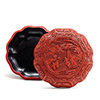
|
Lot: 8044
Shaped like a sunflower petal, the box and lid can be distinguished by their primary and tertiary openings. The body is painted thickly with a red lacquer, while the bottom portion and inner walls are painted black. The inner surface of the upper opening features carved figures of people. Meanwhile the outer portion is decorated with a continuous pattern of one circle to every two squares, the square thunder pattern. A circle at the bottom of the square thunder pattern is engraved with the blessing, Happiness and Longevity. The abdominal wall is comprised of six sets of openings that are decorated on the inside with branches and flowers. Flowers decorate the areas between the openings. The patterns on the outer wall of the box are similar to those on the abdominal section of the lid. With such an elaborate composition, the entire ware features a fine level of craftsmanship that embodies the eighteenth century aesthetic style. |
Estimate
300,000 - 460,000 1,215,000 - 1,862,000 38,700 - 59,300
|
|

|
Lot: 8045
This gilt bronze Buddha figures set is comprised of three items. The two items to the left and right are comfortably seated Taras. In the center, a figure of Vajrasattva sits in the full-lotus posture. The shapes of the three figurines are compact, and feature a fine level of craftsmanship. Bearing solemn expressions, these figures are superb, highly visual products. |
Estimate
110,000 - 170,000 445,000 - 688,000 14,200 - 21,900
|